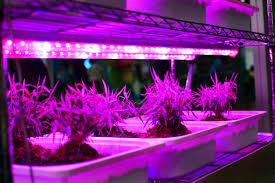Introduction:
Grow Lights Market Size is expected to grow USD 20.7 Billion by 2032, at (CAGR) of 31.20% during the forecast period (2024 - 2032).
In recent years, the global horticulture industry has undergone a significant transformation with the widespread adoption of indoor farming and controlled environment agriculture (CEA). At the heart of this revolution lies the grow lights market, a dynamic sector driven by advancements in LED technology, increasing demand for year-round fresh produce, and the need for sustainable farming practices. This article delves into the burgeoning grow lights market, examining its key drivers, trends, challenges, and future prospects.
Understanding Grow Lights:
Grow lights are artificial light sources designed to mimic the natural sunlight spectrum necessary for plant growth and photosynthesis. They play a crucial role in indoor farming operations, providing illumination for plants in environments where natural sunlight is limited or unavailable. Grow lights enable growers to optimize growing conditions, enhance crop quality and yield, and extend growing seasons beyond traditional outdoor farming.
Key Components of the Grow Lights Market:
- LED Technology: Light-emitting diode (LED) technology has emerged as the dominant lighting technology in the grow lights market due to its energy efficiency, longevity, and ability to produce specific light spectra tailored to plant growth requirements.
- Horticulture Lighting Systems: Grow lights are available in various configurations, including standalone fixtures, integrated lighting systems, and customizable solutions designed to meet the specific needs of different crops and growing environments.
- Spectral Tuning: Grow lights can be tuned to emit specific wavelengths of light, such as blue, red, and far-red, to optimize plant growth, flowering, and fruiting stages.
- Control Systems: Advanced control systems allow growers to adjust light intensity, spectrum, and duration remotely, enabling precise management of growing conditions and optimizing resource use.
Growth Drivers:
- Demand for Year-Round Production: Grow lights enable year-round cultivation of crops, reducing dependence on seasonal fluctuations and geographic limitations and ensuring a consistent supply of fresh produce to meet consumer demand.
- Urbanization and Land Constraints: Urbanization and land scarcity have driven the adoption of indoor farming solutions, prompting growers to utilize vertical farming, hydroponics, and other CEA techniques supported by grow lights.
- Advancements in LED Technology: Continuous advancements in LED technology, including increased efficiency, higher light output, and spectral optimization, have made grow lights more cost-effective and energy-efficient, driving market growth.
- Sustainability Concerns: Grow lights offer significant energy savings compared to traditional lighting sources such as high-pressure sodium (HPS) lamps, aligning with the growing emphasis on sustainable farming practices and energy conservation.
- Emerging Applications: The adoption of grow lights is expanding beyond traditional horticulture to include vertical farming, cannabis cultivation, ornamental plant production, and research applications, further fueling market growth.
Challenges and Considerations:
- Initial Investment Costs: The upfront costs associated with purchasing and installing grow light systems can be significant, especially for large-scale commercial operations, presenting a barrier to entry for some growers.
- Technical Complexity: Designing and implementing effective grow light systems require expertise in horticulture, lighting technology, and environmental control systems, posing challenges for growers without specialized knowledge.
- Heat Management: Grow lights generate heat, which can affect plant growth and increase cooling costs in indoor farming environments, necessitating efficient heat dissipation and climate control measures.
- Regulatory Considerations: The legal landscape surrounding cannabis cultivation, a significant market segment for grow lights, varies by region, with regulations governing lighting, energy consumption, and product quality.
- Lighting Uniformity and Distribution: Ensuring uniform light distribution and coverage across the growing area is essential for maximizing crop yields and quality, requiring careful planning and optimization of lighting layouts.
Future Outlook:
The grow lights market is poised for continued expansion as growers increasingly recognize the benefits of indoor farming and CEA techniques for sustainable, high-yield agriculture. Ongoing innovations in LED technology, coupled with advancements in spectral tuning, control systems, and automation, will drive the development of more efficient, customizable, and cost-effective grow light solutions. Furthermore, as global population growth, urbanization, and climate change continue to exert pressure on traditional farming practices, the adoption of grow lights and indoor farming methods will play an increasingly vital role in ensuring food security and agricultural sustainability.
Read more article -
Micro Display Market Research report – Forecast till 2032
Precision Farming Market Research report – Forecast till 2032
ReRAM Market Research report – Forecast till 2032
SCADA Market Research report – Forecast till 2032
Smart Card Reader Market Research report – Forecast till 2032


